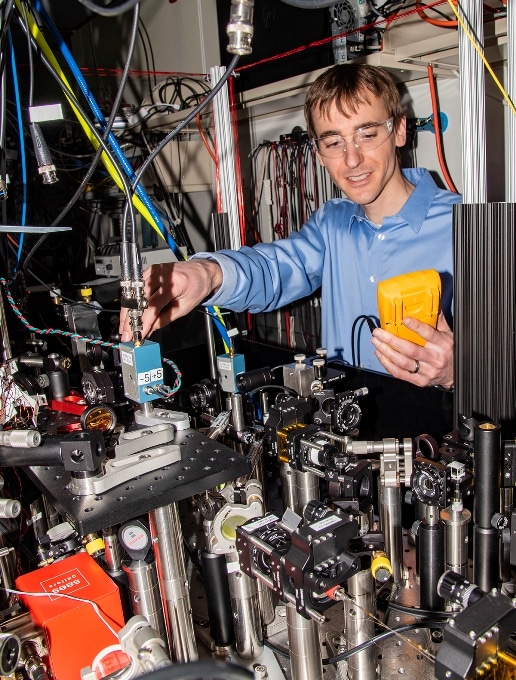Jul 18 2019
The quantum logic clock, which is well known for showing a person to age faster upon standing on a stool, has returned to the superior performance grades of the world’s experimental atomic clocks.
 NIST physicist David Leibrandt adjusting one of the lasers used to operate the quantum logic clock, an experimental next-generation atomic clock based on the “ticking” of a single aluminum ion (electrically charged atom). (Image credit: Burrus/NIST)
NIST physicist David Leibrandt adjusting one of the lasers used to operate the quantum logic clock, an experimental next-generation atomic clock based on the “ticking” of a single aluminum ion (electrically charged atom). (Image credit: Burrus/NIST)
For the past eight years, physicists from the National Institute of Standards and Technology (NIST) have been silently enhancing the design of their quantum logic clock mainly to minimize errors caused by the undesirable motion of the single aluminum ion (electrically charged atom) that offers the clock “ticks.”
The study reported in Physical Review Letters states that the systematic uncertainty (how closely the clock represents the natural vibrations, or frequency, of the ion) of the quantum logic clock is 9.4 × 10−19, the best of any clock across the globe. This suggests that the logic clock would now not gain or lose one second in 33 billion years, which is nearly two-and-a-half times the predicted age of the universe.
In this system of measurement, it currently outperforms both NIST clocks with the help of neutral atoms caught in lattices of laser beams—the strontium lattice clock and the ytterbium lattice clock.
The logic clock’s performance is not surprising to me. Ion clocks are naturally better isolated from the environment—which is the source of inaccuracy for atomic clocks—than lattice clocks are. It’s important to distinguish between precision and stability on this point. People expect that lattice clocks should perform the best in stability, and they currently do. Our newest quantum logic clock is the world leader in precision but not stability.
David Leibrandt, Project Leader, National Institute of Standards and Technology
The stability of the logic clock, or the time it takes to measure the time, is 1.2 × 10−15 for a measurement of 1 second, which is close the optimal value realized by a single ion clock but nearly 10 times worse when compared to both the NIST lattice clocks.
The nickname of the quantum logic clock arises as it borrows logical decision-making methods from experimental quantum computing. Although aluminum is an extremely stable source of clock ticks that vibrates between two energy levels more than a million billion times per second, it is not easy to use lasers to manipulate or detect its properties. Hence, logic operations with a companion magnesium ion are used to cool the aluminum as well as to signal its ticks.
Earlier in 2010, the quantum logic clock developed at NIST had the best performance of any experimental atomic clock and also gained interest for 2010 demonstrations of “time dilation” facets of Einstein’s theories of relativity: that time passes faster at higher elevations yet more slowly when one moves faster.
From that time, the lattice clocks from NIST have been constantly outperforming each other in performance, giving the perception of a race to find out a single winner. Indeed, all the clocks are helpful for research works and are probable competitors for future time standards or other applications.
Since 1967, the international definition of the second (in the International System of Units, or SI) has been based on the cesium atom; therefore, cesium remains the “ruler” for official timekeeping. The logic clock is one competitor for a future time standard to be chosen by the international scientific community.
Researchers from NIST are working on various types of experimental clocks, each based on different atoms and providing its own benefits. All such clocks are based on optical frequencies higher than the microwave frequencies used in existing timekeeping standards based on cesium.
A number of technical advancements paved the way for the enhanced performance of the logic clock, such as a new ion trap design that minimized heat-induced ion motion, thereby facilitating operation near the desirable ground state, or lowest motional energy level.
Moreover, a lower frequency was used to operate the ion trap, thereby minimizing unwanted ion motion due to the electric field applied to trap the ions. Lastly, enhanced quantum control has minimized the uncertainty of frequency shift measurements caused by ion motion.
The precision of the clock was ascertained by measuring and summing up the frequency shifts due to nine different effects. Stability measurement was performed by comparing with NIST’s ytterbium lattice clock.
Additional enhancements in trap design and other aspects have been scheduled to further enhance the performance. Already, three experimental clocks from NIST can be compared to enhance measurements of probable changes in some of the fundamental “constants” of nature—an area of research with vital implications for cosmology and tests of the laws of physics, for example, Einstein’s theories of special and general relativity.
The Defense Advanced Research Projects Agency and the Office of Naval Research supported this study.